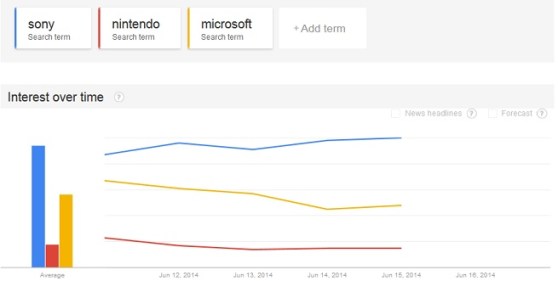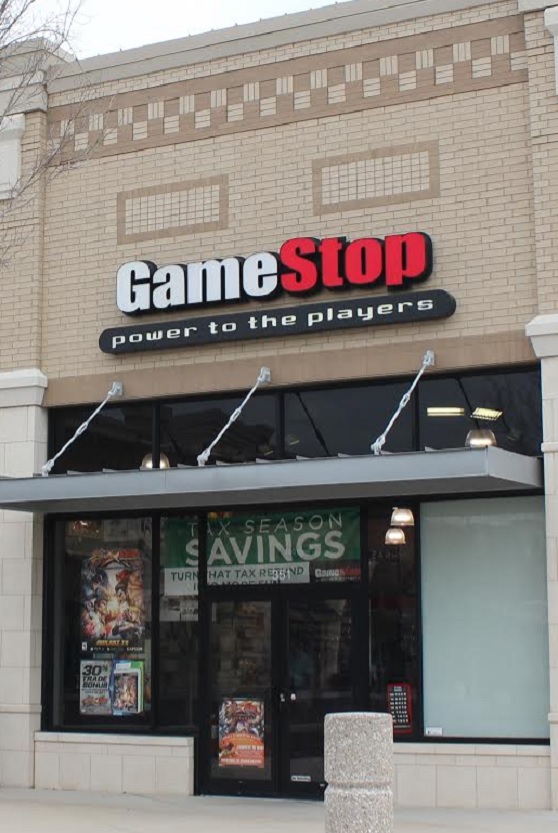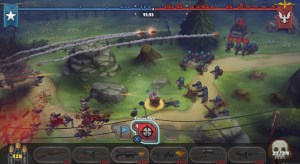As the world’s biggest game retailer, GameStop isn’t feeling doomed because of the threat of digital distribution. Rather, the chain with 6,600 GameStop stores feels a refreshing breeze thanks to a strong May for physical game sales, a price change for the Xbox One, and a hoard of new stuff coming this fall for hardcore gamers.
Tony Bartel, the president of the Grapevine, Texas-based company, said in an interview with GamesBeat that he was excited by all of the new announcements at E3. While summer may have a light release schedule, September through November will be loaded with blockbuster games. Bartel gave us his reactions to many of the major announcements at the show, adding perspective that will help everybody understand what is going to sell and what will be important for the game business in the long haul. The bottom line: He’s optimistic that physical retail will have its place in the larger digital game business — and that GameStop will continue to get 500 million people a year walking through its stores.
Here’s an edited transcript of our chat.
GamesBeat: What were your impressions of the show?
Tony Bartel: First of all, incredible excitement around the category. One has to be impressed by the focus on the gamer, particularly the core gamer, when you watched all the presentations by Microsoft and Sony, EA, and Ubisoft. Very much focused on the gamer. We were excited walking out of there. We had tremendous meetings with all of our publishing partners.
One, it’s going to be a very good holiday. Also, the summer just got stronger, with The Last of Us in late July. When you look at the summer releases, GTA has been announced, and Hardline. We got a good glimpse of those. Evolve looks strong. That was a surprise hit for many people. It was very strong for the core gamer and a huge win for gaming in general.
GamesBeat: We always see a mixed picture there. They announced a lot of new titles, but a lot of others slipped into 2015. How do you balance that out?
Bartel: A few did, which I think is okay. It feels like there’s going to be a plethora of titles in that September-October-November time frame. It’s a very busy time for gamers. We’re constantly working with publishers and saying, “Hey, it’s okay to spread some of those titles out.” We see a very flush September through November. The key is going to be putting those titles in the hands of gamers.
GamesBeat: Otherwise, do you feel like we’re in a bit of a light schedule for the summer? Is it lighter than usual?
Bartel: The fourth quarter is always the highest quarter. With NCAA [Football] not being available this year, that was something we’ll miss from the year before. But we had Watch Dogs, which is doing phenomenally well. We had tremendous acceleration on our pre-sales on that title. That’s a good barometer, when you come into a titles and pre-sales start taking off. We had a very significant additional order right before launch, because knew it was going to be strong. Loved the title and really loved the attach on downloadable content, which was fantastic.
GamesBeat: I’m looking at a Google trends chart from last week. It captures seven days of mentions — Microsoft and Sony and Nintendo. As you would expect, Sony is at 88, Microsoft at 55, and Nintendo at 13. Does that sound right to you, as to what grabbed attention at E3?
Bartel: Given that you had the new system announced by Microsoft a couple weeks prior to E3, that sounds about right. If you would have looked when they announced the Xbox One without Kinect, Microsoft would have been much stronger. They chose to make sure that wouldn’t be a distraction so they could focus on games. It makes sense to me. They did exactly what they wanted to do, which was to say, “Hey, we said some things last year that we decided not to execute against. We want to use this opportunity, in a very public setting, to talk about the fact that we’re all about games.”
Sony, on the other hand, did a lot of those things last year. They were able to maybe expand their message a bit.
GamesBeat: What did you think of the Halo Master Chief Collection? It seems like an interesting innovation in merchandising, taking something that’s already out there and repackaging it.
Bartel: What it shows is the value of the brand. The Halo brand is a phenomenal brand, beloved by gamers. Microsoft did a great job of updating that. I was caught by two things. One was just the thrill of the crowd when they introduced it. That’s a huge barometer of what people like, when you hear the gamers in there. That’s probably one of the loudest cheers they got.
The other thing is, just from a technology standpoint, they’ve been able to not only upgrade the gamers, but also allow you to go back and play it in that retro mode. Clearly that’s going to be a strong seller for them and for us.
GamesBeat: Do you think of that as something as good as a regular Halo launch?
Bartel: That’s hard to predict, how that’s going to work. It’s a series people want to have in their collection. I think it’s going to be strong. I’m not exactly sure how I would put that up against a Halo 5, though. What you’re going to find is that people love innovation. There’s probably more innovation value in a Halo 5, even though they’ve done some really cool things in the Master Chief Collection.
I think it’ll appeal more to people who will want to put that in their catalog. What we’ve seen with new innovation, like Watch Dogs or TitanFall, we’ve seen tremendous consumer support for those titles. The new innovation around Halo 5 will be stronger.
GamesBeat: What do you think of the continuous threat of digital distribution and the changes that come when you get things like Amiibo, these toys you can also sell?
Bartel: I’m not sure there’s exactly a “threat” in digital. The key is all about consumer adoption. We view it as just another consumer option for purchasing a game. If consumers want it digitally, they’ll be able to get it that way, whether at GameStop or directly through their console. The issue of discovery is still important, whether you’re digital or physical.
The other thing about a digital good that the publishers and platform holders are going to need to consider – and this is something that we see more than anyone else in our customer base – is that people who buy a physical game attribute $20 in residual value to that game. If you have no ability to develop a similar program on the digital side, where you give them that $20 of incremental value for a trade-in credit, then it’s going to be difficult for a digital game to sell at the same price as a new game, or even to sell above $40. As an industry, we need to sort that out.
Given that we make $12 on every physical game we sell, there’s a value proposition that has to be considered there. Customers buy a lot more physical games today. They like that model of being able to speak with someone who can help them discover the game. They like to have a physical disc that they can take wherever they want to. They don’t have to wait for a download at any point. When they’re done, they can trade it in and get some additional value.
If people want to go digital, we believe they’re the best place to buy digitally. They can pay with numerous forms of currency. They can generally talk to someone who’s knowledgeable about the game. They can talk to someone who can walk them through the download process, which is an important piece of the transaction
Talking about the toys, clearly it’s a strong and growing category. They’ve brought innovation into it –Activision and Disney have done a nice job of not only evolving the characters, but evolving their games as well. What we’re going to see from Nintendo is the same thing. Again, there’s a physical factor there, as well as a gaming factor.
The key, to me, is innovation. The characters alone aren’t the strength behind it. But the fact that they continue to evolve both the characters and what the characters can do in gameplay, that’s the important feature.
GamesBeat: You guys said that the $400 Xbox Ones are flying the shelves?
Bartel: That was our quote. They are flying off the shelves. We’re seeing strong customer demand. I think the hour they announced it, we began taking pre-sales online and in our stores. Clearly, part of the demand GameStop saw was because of our pre-sale program.
GamesBeat: Were you surprised that there weren’t any last-generation price cuts?
Bartel: I don’t think so. They’ve taken some price cuts earlier, obviously. We weren’t anticipating any at this E3. We still continue to see the Xbox 360 and the PS3, from a software perspective especially, selling very strong. We sell a lot of pre-owned systems at an opening price point, so we satisfy a lot of demand there, and a lot of new hardware as well. I think there’s still demand. I’m sure, as in generations past, they’ll continue to take some price cuts, but for us it would have felt like it was very early to have another cut on those systems.
GamesBeat: As far as the competition between Sony and Microsoft goes, do you think it’s close enough now that it’s a healthy competition?
Bartel: I do. It’s great to have two very strong consoles for the core gamer. Wii U, clearly, has gotten off to slower start than they would have anticipated, but they’ve sold a lot of units. Their best IP is still in front of them. Mario Kart 8 is off to success. We’ve seen that become a system seller for us.
But having two healthy consoles is very strong. The other thing that’s become normalized between the two is the ecosystem behind them, the player ecosystem is stronger. PlayStation Network has made great strides. That’s going to be an important part of the competition as well. It’s not only the system, but also what you can do with the network. We’re seeing competition between Microsoft and Sony both on the hardware and the network behind the scenes.
GamesBeat: How about the weird stuff, like Project Morpheus and Oculus’s Rift virtual-reality headset?
Bartel: I tried both of those on. That’s going to be very interesting. There are differences between the two, obviously. For me, it’s too early to tell. We have to see how customers respond to it. It’s a different experience, definitely. I’ll have to clear out a large space in my living room for Morpheus, because my hands were going everywhere as I was playing that.
If gamers want it, and when gamers want it, we’ll sell more of it than anyone else. I see that as a definite accessory that some people will want. Oculus, I think, is still trying to determine whether it’s going to be a platform that people create to, or whether it’s going to be an accessory that people use for gaming and other applications. You can see the potential there for personalized gaming. I think we all have to figure out exactly what the use case is. It’ll be nice to know more about price points. Then we’ll have a clearer understanding of how deeply our customer base is going to adopt it.
GamesBeat: Were there any other things that caught your attention at the show?
Bartel: There were a few things. One, how focused the industry has gotten. It’s very focused on games, on console games in particular. You saw lots of innovation. Think of all the new IP — Destiny, Hardline would be in that category, Evolve would be in that category. We all knew Watch Dogs by then. I like the innovation.
One of the most impressive demos that I saw was NHL. I don’t know if you saw that at EA, but it was so lifelike. It was almost hard to discern between real life and gameplay. I know that’s more of a niche title, but I was very impressed.
We’re beginning to see people take advantage of the hardware power they have. But to me, it was really all about focus. Lots of good buzz around console gaming. It seems to be alive and well. We’ll see what happens when the next NPD comes out. Do you have a prediction on what software growth is going to be?
GamesBeat: I’ve seen others predicting pretty strong growth year-on-year.
Bartel: Yeah. I think we’ll see that. That’s the number one thing I saw. It felt much more focused to me than it has been in the past, focused on console games.
GamesBeat: When you talk about focus, do you mean that there’s also a lot less as far as casual games out there?
Bartel: That’s what struck me. I will admit that I attended a lot of meetings, unfortunately, covering all of the bigger publishers. But as I walked around the floor, what you saw was a lot of big games made for the console. That’s why I’m talking about focus. In the past, we’ve seen more fringe titles.
Indie was on display both at Microsoft and Sony. Clearly they’re making it easier for people to bring indie games to their platforms. But by and large it was focused on those core console games.
GamesBeat: If you look at this year compared to last year, or years past, are you still confident in the category, then?
Bartel: Absolutely. We’ve said there’s going to be growth in the category. Historically, post-launch I think we’ve seen 10 to 15 percent category growth in consoles. We anticipate that we’ll see growth in consoles. We’re very bullish. It’s the first year. We see multi-year double-digit growth, just like we’ve seen after prior launches. We remain very optimistic.
Clearly we’re optimistic about the uptake on the consoles, with 12 million of the Xbox One and PS4 being sold. That’s more than double the amount that was sold six months after the previous launch. The installed base is growing very quickly.
GamesBeat: What are your thoughts on your own digital business?
Bartel: It’s very strong, very robust. We just recorded, for the last quarter, 9.5 percent digital growth. When we look back on both the year and the last quarter, we’re outpacing the top four publishers in the category. We’re not only participating, but we’re driving it.
If you look at DLC as an example, when GameStop got into the business and started driving DLC at launch and allowing people to discover it along with their games when they were ready to spend money, we found that we really drove DLC. If you recall, when we got into it, nobody was launching DLC and selling DLC season passes at the time of launch. Call of Duty was the first one we did. It was incredibly successful. We shared, with all of the publishers, the success we had. Now it’s pretty well the standard. When you launch a game, you’re going to have a DLC season pass associated with it. We’ve been able to get behind and grow the digital business.
Our mobile publishing business is doing very well. We’ve launched nine games, with more than 10 million installs. We continue to double that business, the Kongregate business, quarter after quarter. We’re very much in the value chain on digital. We’re providing services to customers. We’re helping people discover digital content, which is still not easy to do. We’re helping them afford it. More than 60 percent of the currency used for digital in GameStop is something other than a credit card. Generally, we’re helping people identify great content by talking to people who love games.
GamesBeat: How many stores are you at right now?
Bartel: [We have] 6,600 GameStop stores, globally, [with] 4200 GameStops in the U.S. Then we have 240 additional technology brand stores. They’re changing so fast that it’s hard to keep track. We’re going to add between 300 and 400 technology brand stores this year.
GamesBeat: Is it still something like half a billion people coming into those stores each year?
Bartel: We anticipate about half a billion visits globally in our GameStop stores — GameStop, Micromania, EB Games. It’s all about growth. We came out of E3 a little bit tired, just from all the meetings and conferences we had, but we’re very optimistic about the future.
VentureBeat's mission is to be a digital town square for technical decision-makers to gain knowledge about transformative enterprise technology and transact. Learn More







